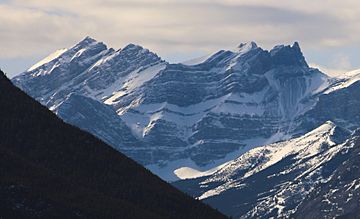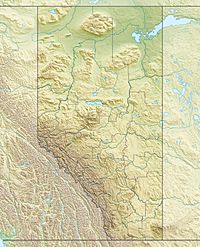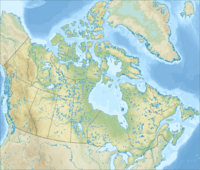Mount James Walker facts for kids
Quick facts for kids Mount James Walker |
|
|---|---|

Mount James Walker seen from the north
|
|
| Highest point | |
| Elevation | 3,035 m (9,957 ft) |
| Prominence | 322 m (1,056 ft) |
| Parent peak | Mount Galatea (3185 m) |
| Geography | |
| Location | Alberta, Canada |
| Parent range | Kananaskis Range Canadian Rockies |
| Topo map | NTS 82J/14 |
| Geology | |
| Age of rock | Cambrian |
| Type of rock | sedimentary rock |
Mount James Walker is a tall mountain peak in Alberta, Canada. It stands 3,035-metre (9,957-foot) high in the beautiful Canadian Rockies. This mountain is part of Kananaskis Country and is found inside Spray Valley Provincial Park. The closest taller mountain is Mount Galatea, which is about 5.0 km (3.1 mi) away to the northwest.
Contents
Discovering Mount James Walker's Name
Who Was James Walker?
The mountain was named in 1959 after a special person, Colonel James Walker (1846-1936). He was a Mountie, which is a police officer in Canada. He was also a soldier and a businessman. Colonel Walker worked as the postmaster for the Kananaskis Post Office.
In 1975, during Calgary's 100th birthday, he was called "Citizen of the Century." The mountain's name became official in 1977. This was decided by the Geographical Names Board of Canada.
Understanding Mount James Walker's Geology
How the Mountain Formed
Mount James Walker is made of sedimentary rock. This type of rock forms from layers of sand, mud, and tiny bits of sea creatures. These layers were laid down over millions of years. This happened during the Precambrian to Jurassic periods.
The Lewis Overthrust
Later, these rocks were pushed up and over younger rocks. This powerful event is called the Laramide orogeny. A huge rock movement, known as the Lewis Overthrust, stretches for over 450 km. It goes from Mount James Walker all the way south to Montana. Nearby Mount Kidd marks the northern end of this major rock fault.
Exploring Mount James Walker's Climate
Weather Conditions on the Mountain
Mount James Walker has a subarctic climate. This means it has very cold, snowy winters. The summers are usually mild. Temperatures can drop below −20 °C. With the wind, it can feel even colder, below −30 °C.
Water Flow from the Mountain
Rain and melting snow from the mountain flow into the Kananaskis River. This river then joins the Bow River. Finally, the water reaches the Saskatchewan River.



